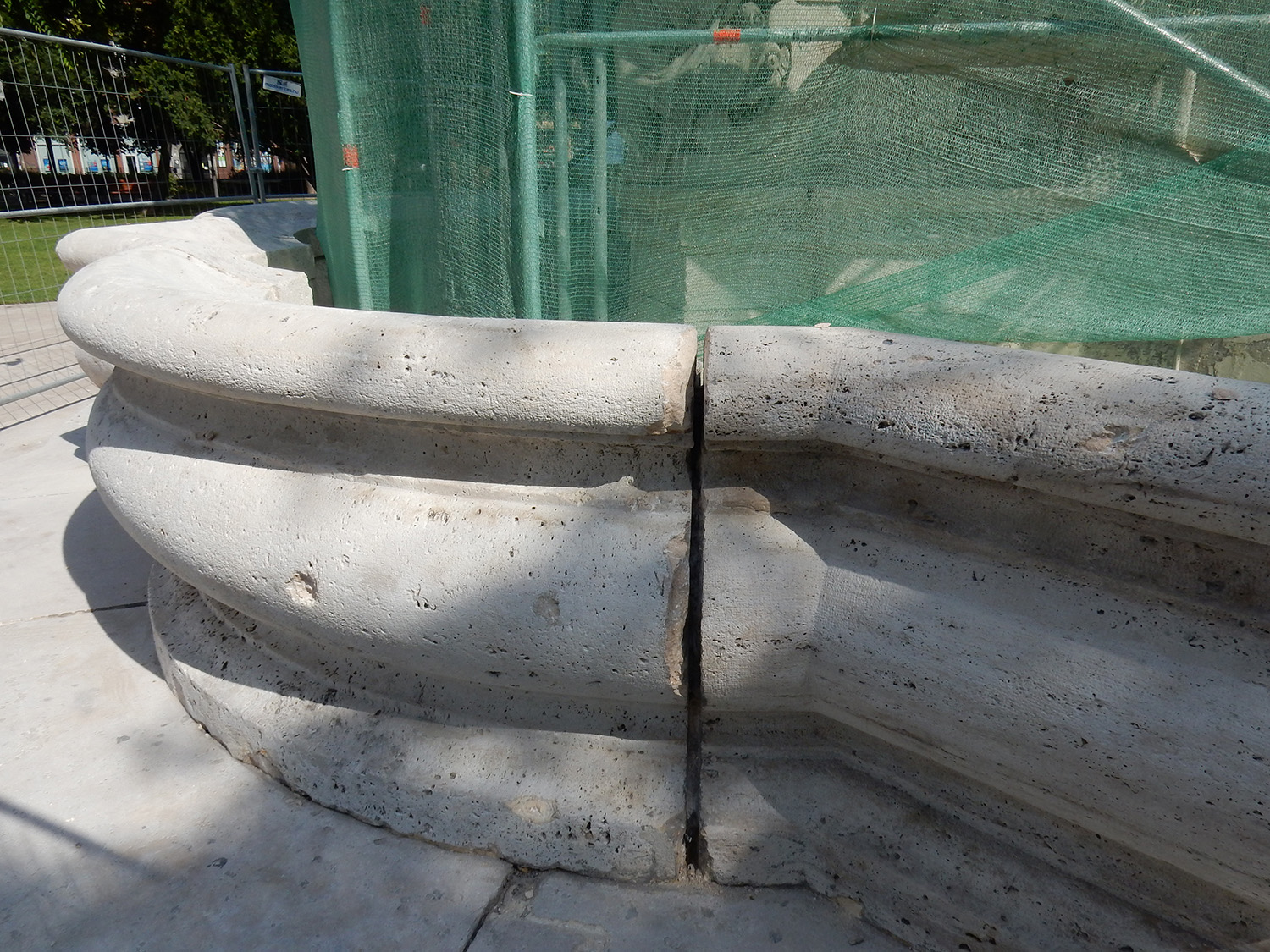One of the most magnificent Neo-Renaissance statues in Budapest depicts the four major rivers of the Carpathian Basin. Danubius, or the Danube, stands on top in male form, surrounded by the female figures of the Tisza, Drava and Sava sitting below. The fountain was last restored in 2000. However, the last twenty years have left their mark on the fragile work of art: air pollution, acid rain and vandalism have all damaged the statues designed by Miklós Ybl (read more about the history of the well here).
 The Danubius Fountain being renovated on Erzsébet Square in September 2020 (Photo: Péter Bukovszki / pestbuda.hu)
The Danubius Fountain being renovated on Erzsébet Square in September 2020 (Photo: Péter Bukovszki / pestbuda.hu)

The female figure of Drava (Photo: Balázs Both/pestbuda.hu)

The Tisza, as a charming young woman, holds a net in both hands (Photo: Both Balázs/pestbuda.hu

Sava – the broken foot of the young lady is clearly visible. This is how the Danubius Fountain stood before renovation (Photo: Ferencváros Local History Collection)
Zoltán Zsolt Varga the leading restorer currently working on the fountain told Pestbuda.hu that several kinds of work are being done on the statues, including using sandblasting and chemical techniques to remove limescale and dirt.

Work on the fountain began two weeks ago (Photo: Péter Bukovszki/pestbuda.hu)
Zoltán Zsolt Varga explained that acid rain and vehicle exhaust can turn limestone into gypsum, the crystals of which are more susceptible to dirt –leading to statues, and decorations on the façades of buildings turning black. These sediments are being removed carefully, to ensure that the original detailed patterns of the carvings become visible again.

The fountain was last restored in 2000, the defects that have appeared since then are being repaired with a special kind of plaster (Photo: péter Bukovszki/pestbuda.hu)
Meanwhile work is being done to pinpoint the most weathered parts of the structure, remove old or inappropriate additions, and other foreign materials.
Missing details will then also be replaced. A unique, form of plaster, specifically designed to the statue and Italian stone will be used for this purpose, as the high-quality travertine limestone of Budakalász is no longer available. Gaps between various stone elements that have occurred due to errors in the statues' placement in 1959 will be grouted with a flexible material, and the foot of the Sava statue – broken by vandals in 2014 – and the toe of another statue will also be re-carved.

The large gaps between the lower large water basin are the results of errors in the statues' original placement in 1959 (Photo: Péter Bukovszki/pestbuda.hu)
The lower basin will be repaired on several points, but as the upper two copper-lined basins are in good condition, those will not be touched.
Some gilding work will also be carried out as the text in the two cartouches (one commemorating the original artists, Miklós Ybl and Leó Feszler, and another the post-war restorer, Dezső Győri) on the fountain also has to be restored.


The gilding of the letters in the two cartouches will also be repaired (Photo: Péter Bukovszki/pestbuda.hu)
Zoltán Zsolt Varga added that the Danubius figure atop the fountain that originally stood on Kalvin Square reflects the influence of the great Italian master, Michelangelo. The position of his hands is similar to that of the Statue of David, while his face is reminiscent of Moses. The details of his body have been worked on with the rigour characteristic of renaissance sculptures: veins and arteries can be seen, though not form ground level.

The Danubius Fountain in its original setting on Kalvin Square photographed by György Klösz in 1900 (Budapest Archives. Reference No.: HU.BFL.XV.19.d.1.08.042/Fortepan/No.: 82567)
The fountain was the largest, and possibly most beautiful fountain in Budapest when completed. However, it was heavily damaged in the siege of Budapest in 1944–1945. The decision to re-carve the statues was eventually made in 1951. The restorer and sculptor tasked with restoring the fountain, Dezső Győri, originally planned to use as much of the original work as possible. However, as this would have lead to a large number of corrections, and a sub-par final product, the whole fountain was eventually re-carved.

The original Sava figure in the courtyard of 9 Kalvin Square (Photo: Ferencváros Local History Collection)
The recreated statue was placed on what is today Erzsébet (Engels square at the time). The statue remains here, but a female figure of the original, Sava, was placed in the courtyard of 9 Kalvin Square as a memento. The statue is still their today and peeking through the gate on Ráday Street anyone can take a look at it.
The ongoing renovation of the Danubius Fountain is expected to end in November, allowing it to emerge from behind the scaffolding in its original glory before the end of the year.
Cover photo: The Danubius Fountain on Erzsébet Square (Photo: Balázs Both/pestbuda.hu)






































Hozzászólások
Log in or register to comment!
Login Registration